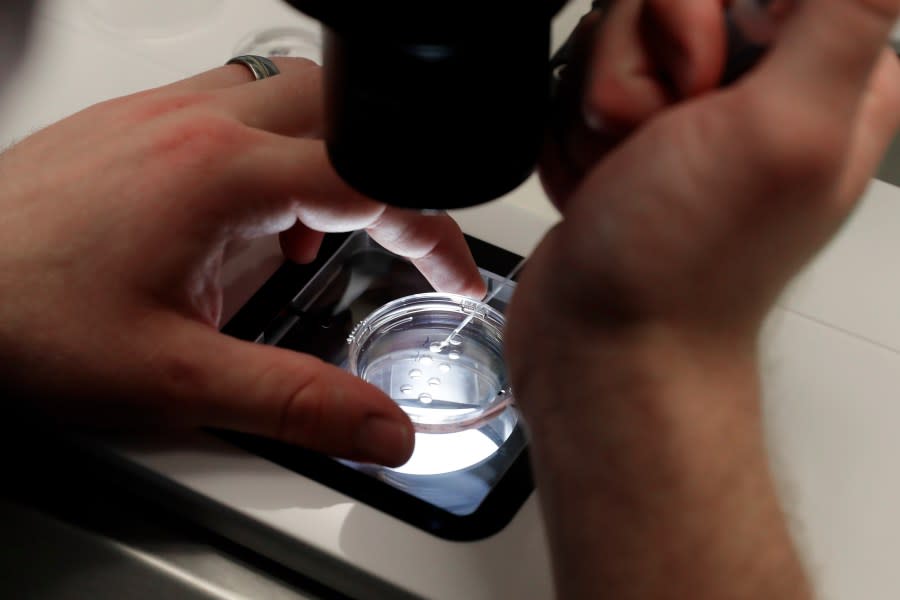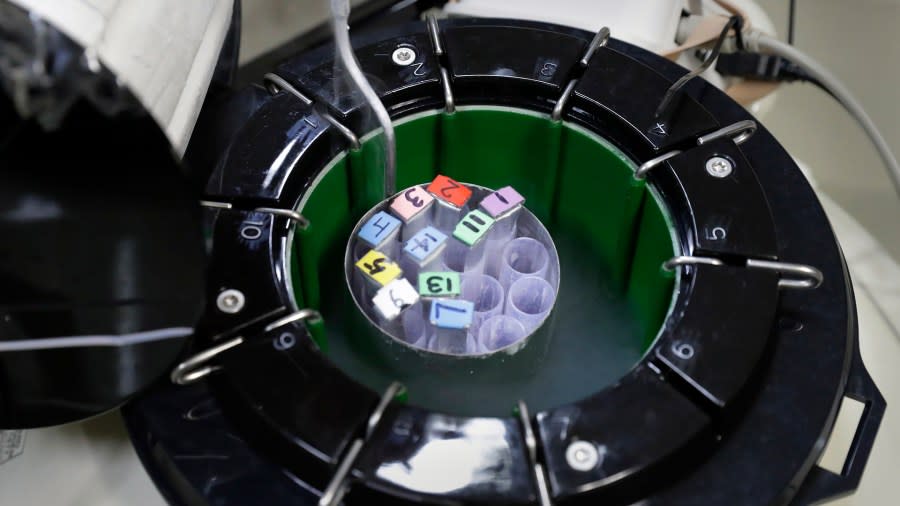IVF is dominating headlines in Alabama and across the country. Here’s what you should know about it

- Oops!Something went wrong.Please try again later.
(AP) — Alabama lawmakers and Gov. Kay Ivey agreed to protect in vitro fertilization providers from legal liability Wednesday, more than two weeks after the Alabama Supreme Court ruled that frozen embryos can be considered children under state law and touched off immediate backlash.
IVF quickly became a talking point for former President Donald Trump, who said he strongly supports its availability. The Biden administration sent the Health and Human Services secretary to Alabama after the ruling, and Virginia Democratic Sen. Tim Kaine is bringing as his guest to Thursday’s State of the Union the first person to be conceived via IVF.
IVF gave hope to patients trying to build their families. The turmoil in Alabama put that in doubt
Three of the state’s major IVF providers had paused services after last month’s decision, which recognized embryos as “extrauterine children,” was issued in wrongful death cases brought by couples who had frozen embryos destroyed in an accident. Wednesday’s new law protects providers from lawsuits and criminal prosecution for the “damage or death of an embryo” during IVF services.
Here’s what to know about this increasingly common fertility treatment.
WHAT IS IVF?
In vitro fertilization offers a possible solution when a woman has trouble getting pregnant. The procedure involves retrieving her eggs and combining them in a lab dish with a man’s sperm to create a fertilized embryo, which is then transferred into the woman’s uterus in an attempt to create a pregnancy.
IVF is done in cycles and may take more than one to create a successful pregnancy, according to The American College of Obstetricians and Gynecologists. The procedure can use a couple’s eggs and sperm or those from a donor.
WHAT IS THE HISTORY OF IVF?
The first baby was born through IVF in 1978 in England. But the first in the U.S. was in 1981 in Norfolk, Virginia, with the birth of Elizabeth Carr.
Her mother, Judith Carr, had had three abnormal pregnancies, forcing the removal of her fallopian tubes. She and her husband sought treatment from Howard and Georgeanna Jones, doctors who opened a fertility clinic at Eastern Virginia Medical School.
The Norfolk clinic faced resistance before it even opened. When it sought a required state certificate in 1979, more than 600 people jammed into a public hearing. Several women voiced support for IVF and testified about wanting to start a family, while anti-abortion groups raised concerns about doctors messing with human conception and embryos being discarded.
Despite proposed state legislation to stop the clinic, it opened in 1980, with others following soon afterward in California, Tennessee and Texas. By 1988, at least 169 in vitro centers were operating in 41 states.
The use of IVF continued to grow. In 2021 alone, nearly 100,000 infants were born as a result of fertility treatments where eggs or embryos were handled outside a woman’s body — primarily through IVF — according to a report from the Centers for Disease Control and Prevention.
But sentiments against IVF never really went away in the American anti-abortion movement, said Margaret Marsh, a history professor at Rutgers University in New Jersey.
White House hits Johnson for uncertainty on IVF ruling
Many abortion opponents had made an uneasy peace with the technology as a treatment for infertility, Marsh said. But opposition to IVF has gained momentum since the overturn of Roe v. Wade in 2022.
“Those who are firmly committed to the idea that life begins at fertilization are circling back to the movement’s earlier opposition,” Marsh said. “Not everyone in the anti-abortion movement opposes these reproductive technologies, but many do.”
HOW ARE EMBRYOS MADE?
The treatment often uses hormones to trigger ovulation so multiple eggs are produced and a needle is used to remove them from the ovaries, the American College of Obstetricians and Gynecologists said.

Eggs can be fertilized by adding the sperm to the eggs in a lab, or a single sperm can be injected into each egg.
“We culture that fertilized egg over a period of time — usually five to six days — to create … the blastocyst. And those are either transferred or stored for future use,” said Dr. Jason Griffith, a reproductive endocrinologist in Houston.
A blastocyst is the early stage of an embryo, which is defined as the state of development that starts at fertilization and lasts up to eight weeks.
Griffith said that on Day 3 after fertilization, an embryo is anywhere from six to 10 cells. By Day 6, it’s between 100 and 300 cells. He added that a person contains more than a trillion cells.
HOW ARE EMBRYOS FROZEN AND STORED?
Frozen embryos can be used for future pregnancies, and the vast majority survive the thawing process.
The freezing process involves replacing the water in embryo cells with a protectant fluid and flash-freezing with liquid nitrogen, according to Johns Hopkins Medicine.
Frozen embryos are stored in tanks containing liquid nitrogen at hospital labs or reproductive medicine centers. Griffith said they can also be kept in storage facilities contracted by health care facilities, especially when they are stored for many years. Frozen embryos can be safely preserved for a decade or more.

Griffith said conditions are monitored in these facilities and there are physical security mechanisms to safeguard the tanks and backup generators in case of power outages.
Dr. John Storment, a reproductive endocrinologist in Lafayette, Louisiana, said his state has a unique law that prohibits doctors from discarding any viable embryos that are still dividing — meaning they must be preserved and stored. So he and other doctors ship embryos out of state to a secure storage facility once a patient has finished using them for a particular IVF cycle.
“Whenever they’re ready for embryos again, they can just ship them back here,” he said. “But we don’t keep them stored here.”
In other states, he said, patients can choose to use them, discard them or donate them to other couples or for research.
HOW COULD THE ALABAMA RULING AFFECT IVF?
The U.S. Supreme Court’s decision to overturn Roe v. Wade sparked speculation about how the ruling could lead to problems with fertility care, said Greer Donley, an associate professor at the University of Pittsburgh School of Law.
Since 2022, four states have amended their constitutions to protect access to abortion, and several others are considering ballot measures for this year. In many, the language goes beyond allowing abortion to give people rights to reproductive freedom more broadly, which could ensure access to IVF.
The recent court decision could “substantially restrict access to a very vital fertility treatment that has helped countless folks today expand their families,” Griffith said. “When you look at the percentage of pregnancies in the United States that result from in vitro fertilization, it’s around 2%.”
Bills aim to update Michigan’s surrogacy laws
It could also increase the cost of IVF for many families — although it’s unclear by how much — because of things like additional storage fees and liability costs, he said. One cycle of IVF, including all embryos transferred, now costs about $15,000 to $25,000, Griffith said.
Storment said the Alabama decision could have a ripple effect across the entire country.
“It’s one of the bigger things to happen in reproductive law in the last decade,” he said.
___
Ungar reported from Louisville, Kentucky. AP reporters Ben Finley in Norfolk, Virginia, and Geoff Mulvihill in Cherry Hill, New Jersey, contributed to this report.
___
The Associated Press Health and Science Department receives support from the Howard Hughes Medical Institute’s Science and Educational Media Group. The AP is solely responsible for all content.
For the latest news, weather, sports, and streaming video, head to WOODTV.com.

